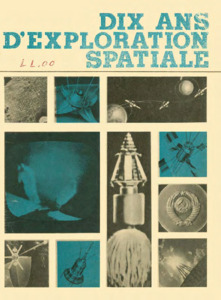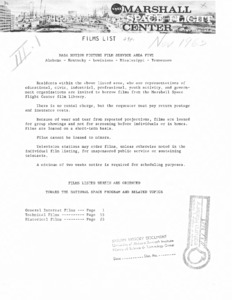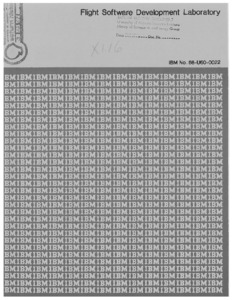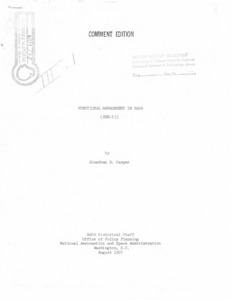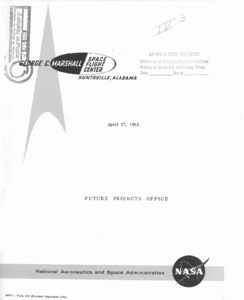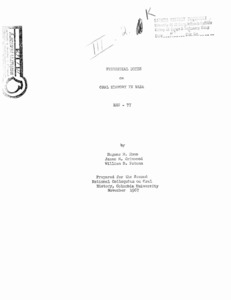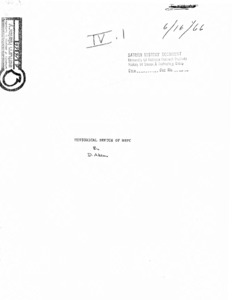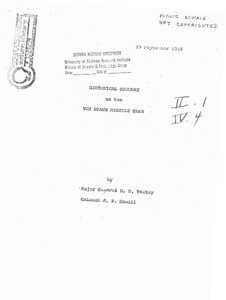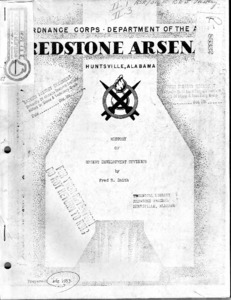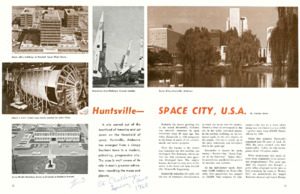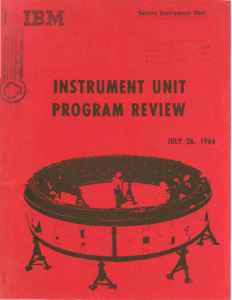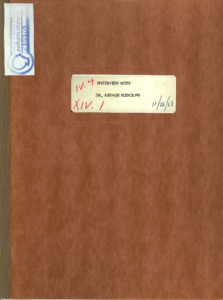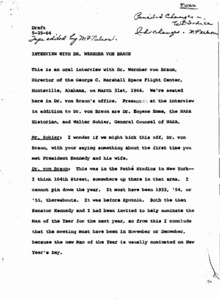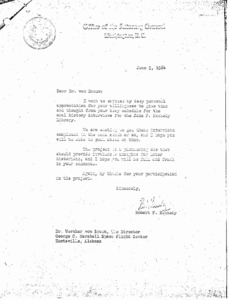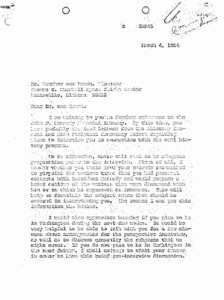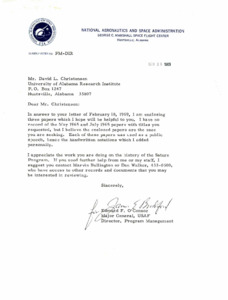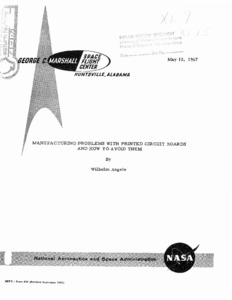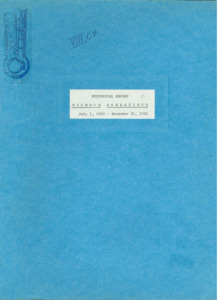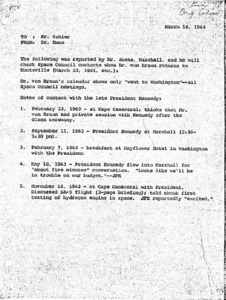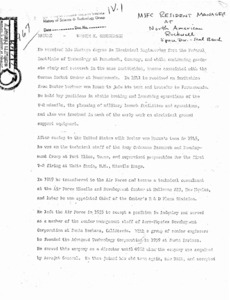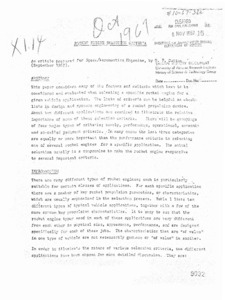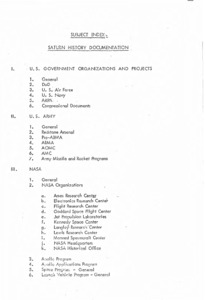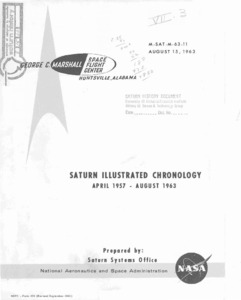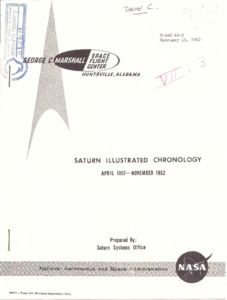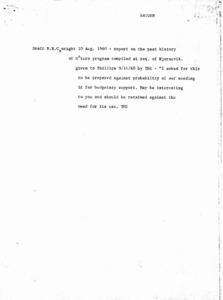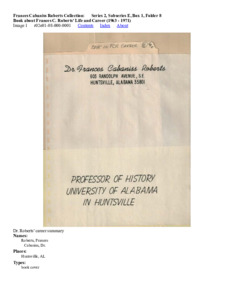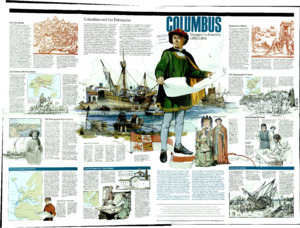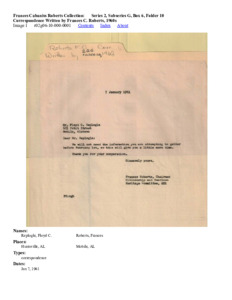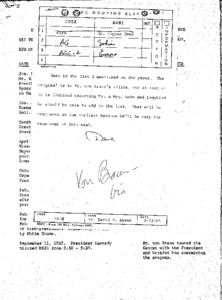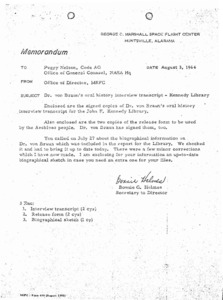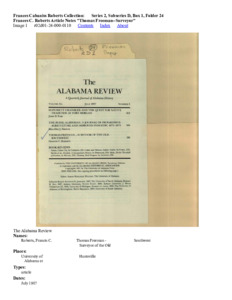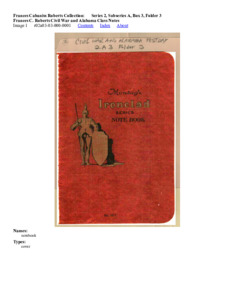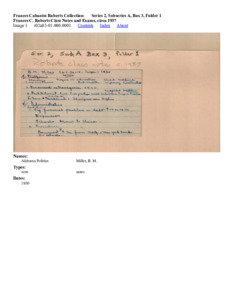
Browse Items (100 total)
Sort by:
-
"Dix ans D'exploration Spatiale."
A series of french articles related to the space program. -
"Failure Investigations of Large Liquid Propelled Rocket Engine Components."
Case histories of seven typical failures in large liquid propelled rocket engines components have been prepared. Quite simple to complex investigations are presented covering a variety of failure modes in a variety of materials. Included are successful solutions to the failure problems investigated.; Archive copy is a poor photocopy. -
"Films List : NASA Motion Picture Film Service Area Five: Alabama - Kentucky - Louisiana - Mississippi - Tennessee."
A list of films oriented towards the National Space Program and other related topics. -
"Flight Software Development Laboratory."
A man-in-the-loop computer facility has been created using a digital computer, display terminal,and space vehicle flight computer to enable programmers to check out flight programs in a simulated space flight environment. The simulation requires a real time multi-programmed environment, which is supplied by a control system capable of scheduling programs on 32 levels of priority interrupt as well as answering demands for service at the display terminal. A special interface device permits visibility and control of the flight program as it executes in the flight computer. On-line inputs from the programmer at the display terminal and outputs from data collection and reduction routines to the display screen are executed in real time. The Flight Software Development Laboratory has proved to be very useful in reducing program preparation time and increasing flight program confidence. -
"Functional Management in NASA."
This is a Comment Edition of Historical Note No. 53 prepared by a summer employee of the NASA Historical Staff (APPH). The author has agreed to integrate comments and corrections submitted by critical readers, a normal process of validation for all historical reports and studies. -
"Future Projects Office."
The purpose of this brochure is to give interested readers, outside as well as within the agencies of the U.S. Government, information on the mission and activities of the Future Projects Office, George C. Marshall Space. -
"Historical Notes on Oral History in NASA."
Prepared for the Second National Colloquium on Oral History, Columbia University. Contains notes on the oral history of NASA. -
"Historical Profile: North American Aviation, Inc."
Paper written as a study of functional management in NASA. -
"Historical Sketch of MSFC."
A rocket from the George C. Marshall Space Flight Center will carry the first American to the moon, and the deadline is 1970. Because of the Center's expanding role in space, there are increasing requests for information about our activities. This brief historical sketch should help to answer questions about our past, our present, and our hopes for the future. Marshall Space Flight Center (MSFC) is the largest installation of the National Aeronautics and Space Administration (NASA). The Marshall Center is NASA's agency responsible for large space rockets and related research. MSFC employs about 7500 civil service employees with an annual payroll of more than {dollar}82 million. In addition approximately 4300 contractor employees work for MSFC on the Arsenal, earning an estimated {dollar}43 million. The Center occupies about 1800 acres near Huntsville, Alabama; in this large area are 270 buildings with floor space totalling about 4,000,000 square feet for a real estate and property value of about {dollar}325 million. MSFC's 1966 fiscal year budget was {dollar}1.8 billion. Obviously MSFC has much human and monetary worth behind United States round trips to the moon and beyond. In addition to its size, MSFC is unique because it has a large rocket development team with more than three decades of experience. Prior to the rocket work that dates back to Peenemuende [sic] the world heard little and cared less concerning rockets and space. As a group Marshall has always thought big. It has worked together as a group, and equally well with fellow scientists throughout the Free World, to get the most into space soonest. This is why there is increasing interest in larger and larger rockets and rocket programs from our Center, a fact generating more and more questions about our Center, and in turn generating a "workload" request for this sketch by the Historical Office. We hope that you enjoy our historical sketch, which could as well be entitled "Closer and Closer Views of the Moon and Beyond." David S. Akens, MSFC Historian. -
"Historical Summary: S & ID Apollo Program."
Four and a half years have passed since President Kennedy and the United States Congress established a national goal of landing a man on the moon, before the end of the decade. This brief history is designed to be a working tool for use during the second half of this great adventure. It is expected that by presenting the events of the past in perspective this document will become a handy reference to accomplishments of the first half of the program. It is hoped that this volume will be of value to those directly and indirectly concerned with North American's portion of the Apollo program. This history contains a chronology of significant events, as well as material on the management of the program, a record of some of the breakthroughs in technology, a report of the hardware produced to date, and the many tests performed to man-rate the equipment. -
"History of Rocket Development Division."
A document recounting the history of the Rocketdyne Development Division -
"Huntsville: Space City, U.S.A."
An article describing Huntsville's role in various space related projects. -
"Instrument Unit Program Review : Saturn Instrument Unit."
Handwritten names and phone numbers on the first page. Apollo / Saturn Team. -
"Interview With Dr. Arthur Rudolph."
Transcription of an interview between Davis S. Akens and Arthur Rudolph -
"Interview with Dr. Wernher von Braun."
Transcription of an interview with Wernher von Braun and Mr. Sohier. -
"Letter to Dr. Wernher von Braun."
This letter asks for an oral history interview from von Braun concerning his conversations and visits with President John F. Kennedy.; Archive copy is a very poor copy. -
"Letter to Dr. Wernher von Braun."
Archive copy is a poor photocopy. Unable to read. -
"Letter to Mr. David Christensen."
Correspondance between Edmund F. O'Conner and David L. Christianson in which Edmund encloses three documents to David and expresses his gratitude for David's work on the history of the Saturn V program. -
"Manufacturing problems with printed circuit boards and how to avoid them."
To be presented at the NASA / Rocketdyne Manufacturing Technology Review. Focuses on how best to avoid printed circuit boards. -
"Michoud operations : historical operations: July 1, 1963 - December 31, 1963."
Historical report from July 1st to December 31st. -
"MSFC technical facilities history and description."
This document includes a brief history of MSFC facilities, defunct names used by various Redstone located missile organizations, Michoud facilities history, the Slidell Operations Office history, the Mississippi Test Facility (MTF) history, and detailed description of technical facilities for the MSFC R&D Laboratories. The final section presents a detailed breakdown of property and facility values for various MSFC facilities over a period of time. -
"Report to Mr. Sohier from Dr. Emme."
Report detailing dates of Dr. Akens Marshall meetings with President Kennedy. -
"Resume - Werner K. Gengelbach."
Letter vouching for the expertise and past accomplishments of Werner K. Gengelbach -
"Rocket engine selection criteria."
This paper considers many of the factors and criteria which have to be considered and evaluated when selecting a specific rocket engine for a given vehicle application. The lists of criteria can be helpful as checklists in design and systems engineering of a rocket propulsion device. About ten different applications are examined to illustrate the relative importance of some of these selection criteria. There will be groupings of our major types of criteria; namely, performance, operational, economic and so-called judgment criteria. In many cases the last three categories are equally or more important than the performance criteria in selecting one of several rocket engines for a specific application. The actual selection usually is a compromise to make the rocket engine responsive to several important criteria. -
"Saturn history documentation: subject index."
This document explains the handwritten numbers on each document.; On spine is the title "Saturn history subject categories." -
"Saturn illustrated chronology : April 1957 - August 1963."
A list of images with detailed descriptions of what they are and their histories. -
"Saturn illustrated chronology : April 1957 - November 1962."
Document detailing the history of the saturn project between April, 1957 through November, 1962. -
"Saturn: draft."
Report on the history of the Saturn program. -
COLUMBUS Voyages to America 1492-1504
Informational poster with illustrated graphics. -
Dr. von Braun's calendars and scrapbooks indicate that these were his personal contacts with President Kennedy, Vice-President Johnson and members of their immediate staff.
The first page contains a typed routing slip. A list of Wernher von Braun's meetings with President Kennedy, the Vice President and members of their immediate staff. -
Dr. von Braun's oral history interview transcript - Kennedy Library: memorandum.
This memorandum references the signed copies of Dr. von Braun's oral history interview for the John F. Kennedy Library.
